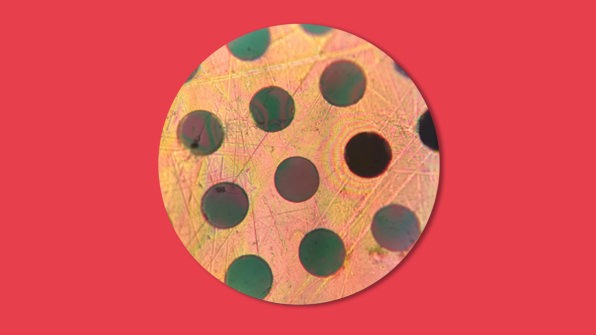- | 11:06 am
MIT scientists create a super plastic that’s 2 times stronger than steel

Plastic has a bad rap. Yes, society has handled it incorrectly, as corporations pump out one-time-use products that end up in our oceans. But as a material unto itself, plastic is wondrous: light, strong, moldable. Plastic enabled the development of airplanes and electronics. And it takes very little energy to produce, unlike glass or steel.
Which is why new research out of MIT, which was just published in the esteemed journal Nature, is so exciting. The team developed an entirely new form of plastic dubbed 2DPA-1. It’s two times stronger than steel under load tests, with just one-sixth the material bulk. It’s capable of conducting electricity and blocking gas. Ultimately, the material has implications for everything from how we build the gadgets we hold in our hands to the buildings we live in, because the patents behind 2DPA-1 are already being licensed by private companies.
To understand why 2DPA-1 is so advanced, I called up Michael Strano, an MIT chemical engineering professor and lead author on the paper, who offered a quick chemistry lesson.
When you look at polymers—aka plastics—at a molecular scale, you’ll see a mess of squiggly molecules that he likens to spaghetti. Unto themselves, these squiggles have strength. The gaps between them are what’s weak. Those gaps are a breaking point, but they also are porous, allowing gas through. They’re why you can smell a hint of last night’s dinner through a ziplock plastic bag.
“Think of a plate of spaghetti: The sauce goes deep inside,” Strano says.

[Image: courtesy of the researchers/MIT News]
However, 2DPA-1’s mechanical properties are only exciting because the material is also relatively practical to produce. To anyone who follows materials science closely, the ultra-strong 2DPA-1 might sound a lot like graphene, another headline-grabbing, two-dimensional material that showcases impossible-sounding traits. But graphene’s limitations are in scaling the material out of the lab. With few exceptions, it’s generated in high temperature ovens—we’re talking about temperatures that can run 1,800 degrees Fahrenheit—directly onto the surface of an object.
“It’s not a way to produce bulk materials,” Strano says. “[With 2DPA-1] you put it in a beaker at room temperature and we can make kilograms of this stuff.” In other words, the conditions you need to make 2DPA-1 is similar to making most other plastics. You just need to start with a monomer (in this case, Strano used melamine as found in dishes) and add some chemical solvents to make thin sheets of 2DPA-1.
You can theoretically stack these sheets over and over to make ultra-light and strong building materials that would put steel to shame. You can roll them up into tiny tubes, then mix them into other plastics to make composites like carbon fiber (which Strano’s team has already demonstrated). But the most immediate commercial implications for 2DPA-1 are as a barrier coating, according to Strano.
We paint everything from our cars to our homes to prevent oxidation, the rust and rot that happens when a material bonds with the oxygen in our air. But because 2DPA-1 can block gasses, “it turns out to be a very good barrier,” Strano says. Those barriers might be sold in the forms of paints or industrial coatings. They might also make their way into formulations for products like ziplock-style bags, which Strano notes could use far less material, more effectively, with 2DPA-1.
In other words, better plastic might allow us to use less plastic for some of the same products. Strano also notes that, since the molecularly similar Kevlar is recyclable, 2DPA-1 should be as well. Which is why, on the horizon, I could see two simultaneous futures for the plastic industry. In one lane, we have super strong plastics (like 2DPA-1) for permanent uses like buildings, that can outperform materials like steel while reducing their carbon footprint. In the other lane, we have other types of naturally sourced ultra-compostable plastics, which we can throw away without the guilt.




































